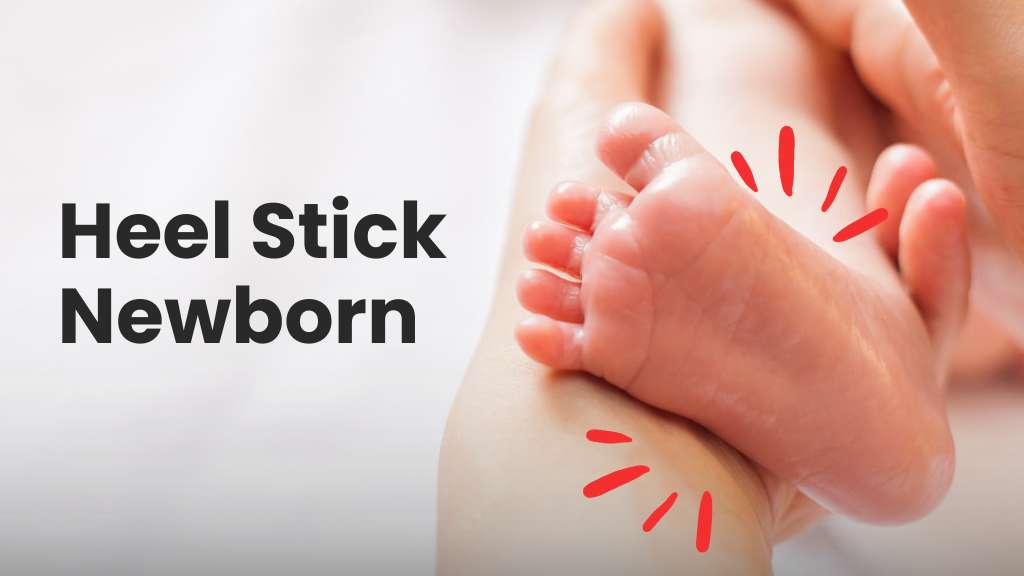
The Department of Health, in a report, stated that each year, almost 3,000 infants test positive for serious genetic, hormonal, or other serious diseases. Screening shortly after birth fosters early intervention, which may result in a considerable decline in the disease’s severity or in most cases, cure it.
One such screening test is the newborn heel stick test.
This article explains the reason for the heel stick test, how it takes place, and what safety precautions are followed to keep your tiny munchkin comfortable.
What is the Heel Stick Test for Newborns?
The newborn heel stick test is used to scan for critical medical problems, like a number of hormonal or metabolic diseases. These diseases don’t have indications at birth. However, they can be very dangerous if left undiagnosed. The infant heel stick test is administered 24 to 48 hours after birth.
The arteries and veins are connected by microscopic blood vessels called capillaries, which transport blood to the tissues. To collect blood samples, the baby’s heel is poked with an infant heel stick— a sharp instrument called a lancet.
When is the Best Time to do the Newborn Heel Stick Test?
Before a baby is discharged from the hospital, a heel stick test is performed. Babies delivered at home must be brought to a local hospital for an infant heel stick test within 24 to 48 hours of birth. In some cases, your little one must also be prescribed a follow-up test within a couple of weeks.
Infant Heel Stick Test Results
In the event that the screening reveals any abnormalities, you will be contacted and recommended for extra testing. There is a considerable chance you won’t hear anything if the test is negative.
Why is the Heel Stick Test for Newborn Done?
One of the most common causes of a heel stick is newborn screening. While there are efforts to establish a nationwide newborn screening program, newborn screening is currently a state-mandated program in the US.
In some instances, successful treatment or even infection prevention can be administered by a premature evaluation of genetic issues. According to a study, over 95% of newborn newborns in the United States get evaluated for about 50 hereditary disorders.
Some of the major diseases that are diagnosed in the heel stick test are:
- Sickle cell disease
- Phenylketonuria
- Cystic fibrosis
- Hypothyroidism
How is the Heel Stick Test for Newborn Done?
The heel stick is carried out on a newborn baby by a pediatrician or a nurse with pediatric care training.
Before the Heel Stick Test
The doctor will make your little one comfortable by swaddling, using lower background noise and light, taking oral sucrose with a filler, or sucking on a pacifier soaked in sugar solution or even a heel warmer.
The Test
As advised by the U.S. Department of Health and Human Services, many states have made it standard practice to screen all infants for up to 35 primary and 26 secondary disorders.
Safety for Heel Stick on Newborn
Even though you might shudder at the idea of your newborn having its heel poked, this test is done to safeguard the infant’s health by following a lot of safety precautions.
Correct Site
The medial and outer perimeters of the heel are the most acceptable places to pierce an infant’s heel. To protect the calcaneus bone (near the posterior heel) the curve in the rear of the heel shouldn’t be utilized for a heel stick. Previously punctured regions should also be avoided.
Complications for Heel Stick Test
The majority of complications during a heel stick may be prevented by taking the necessary precautions. The American Association for Clinical Chemistry states that calcaneus bone and soft tissue might become damaged by improper heel stick technique. Other issues that might arise are:
- Ache
- Infections that can cause
- Cellulitis
- Abscess
- Osteomyelitis
- Scars
- Deep incision
- Incorrect results
Lastly, When Not to Get the Heel Stick Test Done?
The heel stick test is a routine hospital practice that is carried out for every infant, so you don’t even need to ask for it. However, there are certain instances where the heel stick test isn’t performed:
If there is any injury, edema, or infection in the baby’s heel sample region, then the heel stick test isn’t done on the newborn. Further, it is not performed if the amount of blood needed for testing is much more, some types of blood tests, such as:
- Testing for coagulation
- Blood samples
- Chromosomal evaluations
- Titers and immunoglobulins
Heel Stick FAQs:
1. Why is it necessary to warm an infant’s foot prior to a heel puncture?
2. What is the infant heel stick for newborns called?
3. What is the maximum age for a heel stick?
Sources:
- National Library of Medicine, Genetic Alliance; District of Columbia Department of Health, Washington (DC): Genetic Alliance; 2010 Feb 17
- Human Resources and Services Administration, Recommended Uniform Screening Panel, 2022 August
- American Association for Clinical Chemistry, Heel-Stick Sampling, 2013 October 1









